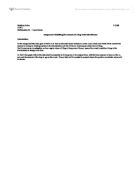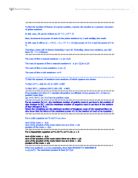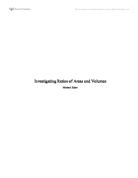parabola investigation
HL MATH PORTFOLIO TYPE 1 PARABOLA INVESTIGATION School : Ted Ankara College Foundation Private High School Candidate: Nazli Deniz BALAMIR 11B 53069 PARABOLA INVESTIGATION Description In this task, you will investigate the patterns in the intersections of parabolas and the lines y = x and y = 2x. Then you will be asked to prove your conjectures and to broaden the scope of the investigation to include other lines and other types of polynomials ) Consider the parabola x2 -6x + 11 and the lines y = x and y = 2x * .Intersection points of the parabola with the line y=x are x2 and x3 x2: 2.38, x3: 4.62 * Intersection points of the parabola with the line y=2x are x3 and x4 x1: 1.76 x4: 6.24 X2-X1 = SL 2.38-1.76= 0.39 X4-X3 = SR 6.24 - 4.62. = 1.39 SR - SL = D 1.39- 0.39 = 1 2)Find the values of D for other parabolas of the form y= ax2 + bx + c, a>0, with vertices in quadrant 1, intersected by the lines y = x and y = 2x. Consider various values of a, beginning with a =1. Make a conjecture about the value of D for these parabolas. * a= 2, b= -10, c =13 f(x) = 2x2-10x+13 X1: 1.40 X2: 1.70 X2-X1= 0.30 X3: 3.78 X4: 4.58 X4-X3= 0.80 D= 0.80-0.30 = 0.50 When a = 2, D = 0.5 * a=3, b= -9, c = 7 y = 3x2-9x+7 X1 : 0.82 X2: 1 X3 : 2.33 X4 : 2.85 X2- X1 = SL =1-0.82 = 0.18 X4-X3 = SR = 2.85-2.33 = 0.52 D= 0.52 - 0.18 =0.33 * a=4 ,
Maths portfolio Crows dropping nuts
Crows Dropping Nuts SL Type 2 Name: Anis Mebarek Teacher: Mr. Grimwood Crows dropping nuts: The table that is provided shows us the average of height and the number of times it takes to break the large nuts from that height. Height of drop .7 2.0 2.9 4.1 5.6 6.3 7.0 8.0 0.0 3.9 Number of drops 42.0 21.0 0.3 6.8 5.1 4.8 4.4 4.1 3.7 3.2 Line graph depicting the table above, showing the frequency of drops by the height of the drop for a large nut. There numerous variables used for this graph. One such is the height at which the nut should be dropped affected the frequency, and this variable is put into an average. Another variable is the frequency of drops is also an average, where is it impossible to have 6.8 times of drops to open a nut. This has been converted into an average because it provides much clearer data, which could be put into one graph and distinguish the equation for it. Another variable is the size of the nut, where "large" is not very scientific and can vary in size and shape, which will consequently alter the frequency of drops it takes for it to crack open. Hence by creating a size range for the "large" nut will help to identify and shape the model better. One such parameter that could be seen from the graph is the asymptotes, one on the y-axis and the other on the x-axis. This clearly suggests that this is not a precise graph,
Modelling the amount of a drug in the bloodstre
Matthieu Robin 1/12/08 1PCL Mathematics SL - Layla Moran Assignment: Modelling the amount of a drug in the bloodstream Introduction In this assignment the main goal of Part A is to find an adequate linear function to model a non-linear set of data which records the amount of a drug for treating malaria in the bloodstream over the 10 hours following an initial dose of 10µg. Part B requires an investigation on how regular doses of 10µg of drug every 6 hours, causes the overall quantity of drug in the bloodstream to change over time. In Part A the graph with all the data shall be presented as it was given in its original form, with the time measure in hours on the x-axis and the amount of the drug in µg on the y-axis. Then a table will be created to present clearly the positive coordinate values will be shown. Part A The table below shows all the coordinate values of the graph to the nearest tenth of a unit. Time will be represented by the variable x and the amount of drug will be represented by the variable y. Time in hours 0 0.5 .5 2 2.5 3 3.5 4 4.5 5 5.5 6 6.5 7 7.5 8 8.5 9 9.5 0 Amount of drug in µg 0 9 8.3 7.8 7.2 6.7 6 5.3 5 4.6 4.4 4 3.7 3 2.8 2.5 2.5
Continued Fractions
Continued Fractions A continued fraction is any mathematical expression in the form of: Where a0 is always and integer, and all other ''s such as a1, a2, and a3 are positive integers. The number of terms can either be finite or infinite. A more convenient way to denote continued fractions such as the one above would be to denote it by: Finite Continued Fractions A finite continued fraction is an expression such as the one shown above which could end. Every rational number can be equated to a finite continued fraction. The only skill needed would be division of fractions. Infinite Continued Fractions Unlike the finite continued fractions, the chain of fractions never ends in an infinite continued fraction. Every irrational number can be equated to an infinite continued fraction. This fact was discovered and proven by the Swiss Mathematician, Leonhard Euler (1707-1783). Some of Euler's infinite continued fractions are as we will see below: A way to summarise this expression is to let denote the value of the continued fraction. Usage of Continued Fractions Continued fractions could be used to solve certain quadratic equations of the second degree. Solving a quadratic equation using the 'completing the square' method only gives the roots of the equation, on the other hand solutions are often required to be expressed as a fraction or decimal fraction. That is
The following data in table #1 describes the flow rate of the Nolichucky River in Tennessee between 27th of October 2002 and 2nd of November 2002,The following data in table #1 describes the flow rate of the Nolichucky River in Tennessee between 27th of O
The following data in table #1 describes the flow rate of the Nolichucky River in Tennessee between 27th of October 2002 and 2nd of November 2002, taken from the web site: water.usgs.gov/pub/wri934076/stations/03465500.html. And in this portfolio we are going to investigate the relationship between the flow of water and time in order to have understanding of the amount of flow of water and the change of the rate of flow. Table #1: The original data for the flow rate of Nolichucky River in Tennessee between 00:00 27th of October 2002 and 00:00 2nd of November 2002 (the time is measured in hours past midnight, and the flow rate is measured in cubic feet per second [cfs]):- Time / (Hours) Flow / (cfs-1) 0 440 6 450 2 480 8 570 24 680 30 800 36 980 42 090 48 520 54 920 60 670 66 440 72 380 78 300 84 150 90 060 96 970 02 900 08 850 14 800 20 780 26 740 32 710 38 680 44 660 Graph #1: Graph of the original data for the Flow vs. time: The line of best fit is the best approximation of a function for a set of data. However, our original data for the flow rate of Nolichucky River in Tennessee seems to be divided into two functions, one function is increasing, while the other function is decreasing. And in such case we can use the idea of a split function in finding the function of the graph. And as we can notice the shape of
Math portfolio stellar numbers. This assessment will investigate geometric shapes that lead to special numbers.
Math Portfolio Type 1 Stellar numbers Student: Alehsan petersen Class: IB08A This assessment will investigate geometric shapes that lead to special numbers. An example of this would be square numbers (1,4,9,16...), which can be represented by squares of side (1,2,3,4...). First, triangles will be investigated. The number of dots (1,3,6,10,15...) in each triangle is a triangular number, which will be labelled Tn, the triangular sequence of n. One can see that these triangles are equilateral triangles, where the nth triangle has n number of dots on each side. It can be observed that the increase in dots follows the pattern 1, 1+2, 1+2+3, 1+2+3+4, 1+2+3+...+n. Therefore one can derive other numbers for Tn. n Tn difference d difference d2 2 3 2 3 6 3 4 0 4 5 5 5 6 20 6 7 27 7 8 36 8 9 45 9 0 55 0 Since one is dealing with a triangular shape it would be likely to investigate if the double amount of dots, a rectangular shape, gives a pattern. The sequence of the rectangle is called Rn.( 2,6,12,20,30......) Observing Rn and the table one realizes that ever since d2 seems to be an arithmetic sequence, it is indicated that Tn itself could have a quadratic formula as its generator.Actually,one can that the square of n plus n gives Rn. Expressing this mathematically, Rn = Since Rn=2Tn one can substitute Rn in order to get Tn, 2Tn=
MATHS shortcuts
++++++++++++++++++++++++++++++++++++++++++++++++++++++++++ To find the number of factors of a given number, express the number as a product of powers of prime numbers. In this case, 48 can be written as 16 * 3 = (24 * 3) Now, increment the power of each of the prime numbers by 1 and multiply the result. In this case it will be (4 + 1)*(1 + 1) = 5 * 2 = 10 (the power of 2 is 4 and the power of 3 is 1) Therefore, there will 10 factors including 1 and 48. Excluding, these two numbers, you will have 10 - 2 = 8 factors. ++++++++++++++++++++++++++++++++++++++++++++++++++++++++++ The sum of first n natural numbers = n (n+1)/2 The sum of squares of first n natural numbers is n (n+1)(2n+1)/6 The sum of first n even numbers= n (n+1) The sum of first n odd numbers= n^2 ++++++++++++++++++++++++++++++++++++++++++++++++++++++++++ To find the squares of numbers near numbers of which squares are known To find 41^2 , Add 40+41 to 1600 =1681 To find 59^2 , Subtract 60^2-(60+59) =3481 ++++++++++++++++++++++++++++++++++++++++++++++++++++++++++ If an equation (i:e f(x)=0 ) contains all positive co-efficient of any powers of x , it has no positive roots then. eg: x^4+3x^2+2x+6=0 has no positive roots . ++++++++++++++++++++++++++++++++++++++++++++++++++++++++++ For an equation f(x)=0 , the maximum number of positive roots it can have is the number of sign changes in f(x) ;
Matrix Powers Portfolio
Matrix Powers: Type I Matrices are useful mathematical tools that help us to interpret, represent, and ultimately understand information. By comparing matrices in their original form, , we can observe specific patterns that are helpful in interpreting information demonstrated using matrices. But, in some specific cases, the determinant of said matrices must be calculated in order to see a specific correlation. This investigation analyzes relationships between both matrices and determinates of differing powers. It further presents a general rule that can be used to calculate a specific pattern for any power. When considering the matrix: , an expression for the matrix of Mn in terms of n can be found by simply formalizing an observed pattern of the matrix Mn where n=1,2,3,4,5,6,7,8,9,10,20,50. After plugging the matrix M into a graphing calculator, M to the previously stated powers can be easily calculated using the "^" key. After making these calculations, the results obtained can be observed below in Table 1.1. Table 1.1 Power Matrix n = 1 n = 2 n = 3 n = 4 n = 5 n = 10 n = 20 n = 50 An obvious pattern can be seen above, in which as the power n increases, so do the numbers in the top left portion (a) and lower right portion (d) of the matrix, while the other two values stay constant at zero. In fact, the numbers in the top left and lower right increase
Series and Induction
#1 Series and Induction In this portfolio, I will be investigating a pattern and forming conjectures to explain what happens when k = 2, 3, or 4 in the 1k + 2k k + 3 k + 4 k + ... + n k series. To do this, I will be using the knowledge that 1 + 2 + 3 + ... + n =. . where a1 = 1 x 2 a1 = 1 x 2 a2 = 2 x 3 a3 = 3 x 4 a4 = 4 x 5 . . . Expression seems to show that an = n(n+1) 2. Consider Sn = a1 + a2 + a3 + ... + an where ak is defined in #1 [ak = n(n+1)] a) Determine several values of Sk, including S1, S2, S3, ..., S6 S1 = a1 = 1 x 2 = 2 S2 = a1 + a2 = S1 + a2 = 2 + 2 x 3 = 8 S3 = a1 + a2 + a3 = S2 + a3 = 8 + 3 x 4 = 20 S4 = a1 + a2 + a3 + a4 = S3 + a4 = 20 + 4 x 5 = 40 S5 = = a1 + a2 + a3 + a4 + a5 = S4 + a5 = 40 + 5 x 6 = 70 S6 = a1 + a2 + a3 + a4 + a5 + a6 = S5 + a6 = 70 + 6 x 7 = 112 It seems that for every increasing value of k, the sum of the previous numbers plus the new number yields the new sum. All sums are multiples of 2. b) Thus, the conjecture is that: Sn = Sn-1 + an c) Prove conjecture by induction: Step 1 Assume the conjecture to be true for n = 1 As shown above, S1 = a1 = 1 x 2 = 2 S2 = a1 + a2 = 2 + 2 x 3 = 8 S3 = a1 + a2 + a3 = 8 + 3 x 4 = 20 Step 2 Assume the conjecture to be true for n = k (done in part a of 2) So Sk = a1 + a2 + a3 + ... + ak = Sk-1 + ak Step 3 Observe for if n = k + 1 Should be: Sk+1 = Sk + ak+1 So
Investigating ratio of areas and volumes
Investigating Ratios of Areas and Volumes Michael Zuber Introduction: This paper has been separated into three parts: Part i investigates the ratio of the areas formed when y = xn is graphed between two arbitrary parameters x = a and x=b such that a<b. Part ii investigates the ratio of the volumes formed around the x-axis when y = xn is graphed between two arbitrary parameters x = a and x=b such that a<b. Part iii investigates the ratio of the volumes formed around the y-axis when y = xn is graphed between two arbitrary parameters x = a and x=b such that a<b. To investigate these ratios the program Autograph 3.20 was used in order to obtain sets of results. All areas were found using Simpson's rule at 50 divisions. Part i: Introduction: In this investigation the ratio of the areas formed when y = xn is graphed between two arbitrary parameters x = a and x=b such that a<b will be investigated. This investigation will investigate the ratio area A: area B. Area A is the area contained in between the graph and the y-axis between the arbitrary parameters x = a and x = b. Area B is the area contained in between the graph and the x-axis between the arbitrary parameters x = a and x = b. However, in investigating this there is a small problem. Using modern technology the area between the graph and the x-axis can easily be found. However, not all programs allow for the area











